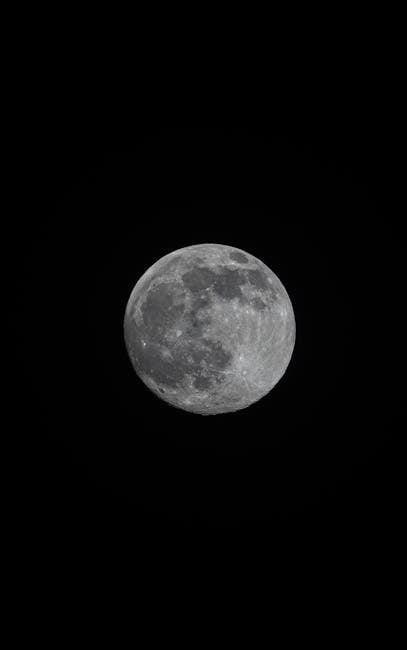Phases of the Moon Worksheets: An Overview
Moon phases worksheets are an educational resource designed to teach students about the lunar cycle․ These worksheets offer interactive activities covering labeling, sequencing, and drawing the phases․ They aid in understanding the moon’s changing appearance․
The moon’s phases describe the varying appearances of the moon as it orbits Earth․ The moon itself doesn’t produce light; instead, sunlight reflects off its surface․ We see different amounts of this reflected light depending on the moon’s position relative to the Earth and Sun․ This creates the familiar phases, like the New Moon, when the side facing Earth is unlit, and the Full Moon, when it’s fully illuminated․ Worksheets introduce these concepts, helping students learn about the cycle, including crescent, gibbous, and quarter phases․ By studying these, children grasp the dynamic relationship between Earth, Moon, and Sun․

Understanding Moon Phases
The phases arise from the moon’s orbit around Earth․ Sunlight reflects differently as the moon moves․ This creates the various shapes we observe․ Learning these patterns helps students understand celestial mechanics․
The Eight Phases of the Moon
The lunar cycle consists of eight distinct phases․ It begins with the New Moon, which is often not visible from Earth․ Then comes the Waxing Crescent, followed by the First Quarter․ Next is the Waxing Gibbous, leading to the Full Moon․ After the Full Moon, the cycle reverses with the Waning Gibbous․ The Third Quarter, also known as the Last Quarter, is next․ Finally, the Waning Crescent completes the cycle before returning to the New Moon․ Understanding these phases is crucial for astronomy․
Types of Moon Phase Worksheets
Various moon phase worksheets exist to cater to different learning styles․ These include labeling exercises, drawing activities, and sequencing tasks․ Each type offers a unique approach to understanding the lunar cycle effectively․
Labeling Worksheets
Labeling worksheets focus on identifying and naming the different phases of the moon․ Students are provided with diagrams and must correctly label each phase, such as New Moon, First Quarter, Full Moon, and Third Quarter․ These worksheets reinforce vocabulary related to the lunar cycle; They enhance recognition of each phase’s unique appearance․ Labeling tasks improve students’ understanding of the sequential order․ They promote visual learning and memory retention of moon phases․ These are often used as quick homework assignments․
Drawing and Coloring Worksheets
Drawing and coloring worksheets engage students creatively while reinforcing their knowledge of moon phases․ Students are tasked with drawing each phase based on its description․ They can also color pre-drawn images to match the appearance of the moon during each phase․ These activities enhance artistic skills while improving understanding․ Coloring helps students visualize the varying degrees of illumination․ Drawing encourages them to observe and replicate each phase’s distinct shape․ These interactive tasks make learning about the lunar cycle more memorable․ They promote visual and kinesthetic learning․
Sequencing Worksheets
Sequencing worksheets help students understand the order of the moon phases․ Students must arrange images of the moon in the correct sequence from New Moon to Full Moon and back․ This activity reinforces the cyclical nature of the lunar phases․ These worksheets often include descriptions of each phase to aid in the sequencing process․ By correctly ordering the phases, students demonstrate their comprehension of the lunar cycle․ The activity enhances critical thinking and reinforces visual recognition of the moon’s changing appearance․ Sequencing helps students internalize the continuous progression of the lunar phases․
Moon Phases and Earth-Sun Positioning
Understanding the moon phases involves recognizing their relation to Earth and the Sun․ Worksheets explain how their relative positions create different illuminated portions visible from Earth, resulting in the phases․
Explaining the Cause of Moon Phases
Moon phases are caused by the changing angles at which we view the moon’s illuminated surface․ As the moon orbits Earth, sunlight reflects differently, creating the illusion of varying shapes․ Worksheets often illustrate this concept using diagrams showing Earth, the Sun, and the moon in different positions․ These visuals help students grasp that the moon itself doesn’t change shape; rather, our perspective of the illuminated portion alters; This understanding is reinforced through activities within the worksheets, solidifying the relationship between celestial body positions and observed lunar phases․

Activities with Moon Phase Worksheets
Moon phase worksheets can be used with hands-on activities, like creating a moon phase model․ Students can also engage in moon observation activities, tracking the phases over time and recording their observations․
Creating a Moon Phase Model
Creating a moon phase model is an engaging activity that complements moon phase worksheets․ This hands-on project allows students to visualize and understand how the moon’s phases change․ Students can use materials like styrofoam balls and lamps to simulate the Earth, Moon, and Sun’s relative positions․ By manipulating these elements, they can observe how different angles of sunlight create the various moon phases․ This kinesthetic learning experience reinforces the concepts learned from the worksheets, making it easier for students to grasp the relationship between the Moon’s orbit and its appearance from Earth․
Moon Observation Activities
Moon observation activities provide a real-world application to complement moon phase worksheets․ Students can track the moon’s phases over a month, recording their observations․ This involves noting the moon’s shape, position in the sky, and time of appearance․ Combining these observations with worksheet knowledge enhances comprehension․ Students can compare their findings to predicted phases, identifying discrepancies and exploring reasons for them․ This fosters critical thinking and reinforces understanding of the lunar cycle․ This hands-on approach connects theoretical knowledge from worksheets to tangible experiences, creating a deeper learning impact․
Target Audience for Moon Phase Worksheets
Moon phase worksheets primarily target educators and students in elementary grades․ Homeschooling families also find these worksheets helpful for science lessons․ The content is designed to be accessible and engaging for young learners․
Grades 2-5
Typically, moon phase worksheets are most effective for students in grades 2 through 5․ At this level, children have the foundational skills to understand the lunar cycle․ The worksheets provide a visual and interactive way to learn about the different phases․ Activities like labeling and sequencing help reinforce learning․ These resources introduce basic astronomy concepts in an engaging manner․ The content is tailored to match the curriculum for these grades․ Educational games and puzzles related to moon phases can be a fun addition, making learning more enjoyable and memorable for the students․

Benefits of Using Moon Phase Worksheets
Moon phase worksheets offer an engaging way to learn about lunar cycles․ They improve understanding through visual aids and interactive tasks․ These worksheets enhance retention and make learning about astronomy fun and accessible․
Educational and Engaging Tool
Moon phase worksheets serve as an educational tool by visually representing complex lunar cycles, making them easier to understand․ Their engaging activities, such as labeling and sequencing, promote active learning and retention․ Students explore the relationship between the Earth, Sun, and Moon in an interactive way․
These worksheets cater to different learning styles, offering visual, kinesthetic, and reading-based activities․ By combining education with engagement, they transform learning about astronomy into an enjoyable and memorable experience․ They help make the moon and its phases seem less distant․

Where to Find Moon Phase Worksheets
Numerous websites offer printable moon phase worksheets for educational purposes․ These resources often provide free PDF downloads suitable for various grade levels․ Educators and parents can easily access these materials online․
Free Printable Resources
Finding free, printable resources for moon phase worksheets is convenient․ Many educational websites offer these PDFs, catering to different age groups and learning styles․ These resources often include a variety of activities, such as labeling diagrams, sequencing the phases, and even coloring pages․ Teachers and parents can easily download and print these worksheets for classroom or home use․ They provide an engaging way to learn about the lunar cycle and the relative positioning of the Earth, Sun, and moon․ Furthermore, many sites offer answer keys for easy assessment․
